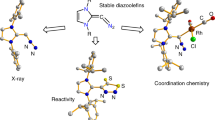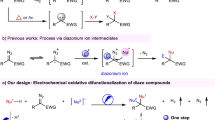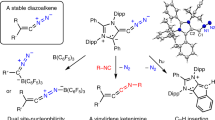Abstract
IN relation to work recently summarized1, we have under investigation a number of diazo-oxides. Certain of those theoretically derived from o- and p-aminophenols (and their derivatives) are included. Satisfactory formulations for these have been debated for years2,4. Earlier writers proposed structures involving rings, such as I3,4 or II5, or quinonoid forms, such as III6. Hodgson and Marsden2 conclude, however, that both the o- and the p- series are best regarded as resonance hybrids of the type
This is a preview of subscription content, access via your institution
Access options
Subscribe to this journal
Receive 51 print issues and online access
$199.00 per year
only $3.90 per issue
Buy this article
- Purchase on Springer Link
- Instant access to full article PDF
Prices may be subject to local taxes which are calculated during checkout
Similar content being viewed by others
References
Calderbank, Le Fèvre and Northcott, J. Soc. Chem. Ind., 158 (1948).
Hodgson and Marsden, J. Soc. Dyers. Col., 59, 271 (1943).
Bamberger, Ber., 28, 837 (1895).
Morgan and Porter, J. Chem. Soc., 107 645 (1915).
Klemenc, Ber., 47, 1407 (1914).
Wolff, Annalen, 312, 119 (1900).
Wyman, Chem. Rev., 19, 213 (1936).
J. Chem. Soc., 1566 (1947).
Author information
Authors and Affiliations
Rights and permissions
About this article
Cite this article
ANDERSON, J., LE FÈVRE, R. Diazo-Oxides. Nature 162, 449–450 (1948). https://doi.org/10.1038/162449a0
Issue Date:
DOI: https://doi.org/10.1038/162449a0
Comments
By submitting a comment you agree to abide by our Terms and Community Guidelines. If you find something abusive or that does not comply with our terms or guidelines please flag it as inappropriate.



